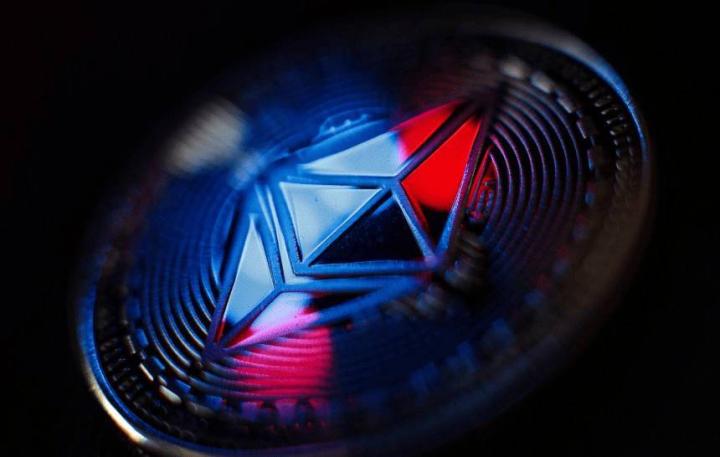Written by David, TechFlow
“I feel like I’m a somewhat useful idiot at the Ethereum Foundation.”
On October 19, an open letter written a year and a half ago was posted on Twitter, and this sentence in it quickly ignited discussion in the crypto community.

The writer wasn’t some fringe Ethereum troll, but Péter Szilágyi:
The former head of the Geth client, which maintained more than 60% of Ethereum nodes, and a core developer who has worked in this ecosystem for 9 years.
Does it feel familiar?
If you’ve been following Ethereum long enough, you’ve seen this scenario play out every few months:
Criticism of the Foundation (EF) suddenly erupted, the community fell into heated discussion, Vitalik responded, and then everything calmed down until the next outbreak.
In 2022, there will be concerns about centralization after the merger, in 2023, there will be conflicts of interest among researchers, and in 2024, there will be issues of L2 fragmentation.
Now, the powder keg has been ignited by an old letter.
The description of “useful fool” is like a knife, piercing a long-maintained illusion and hurting the hearts of many Ethereum ecosystem contributors.
Core contributors who rarely criticize publicly, including Polygon founder Sandeep and DeFi founder AC, have come forward one after another. The message they conveyed can probably be summed up in one sentence:
We have been let down.
The specific questions they raise get to the heart of the matter: Where did the money go? Why do the most loyal get the least? And who truly controls the direction of Ethereum?
These questions are actually old news, but when they come from the mouths of Ethereum's most core contributors, the situation and weight may be completely different.
We can first read this letter carefully to see what a technical leader who has worked in Ethereum for 9 years has experienced that would make him describe himself as a fool.
Nine years of loyalty, one disappointment
When Péter Szilágyi wrote this letter on May 22, 2024, he was probably in the middle of a painful cycle.
The letter began with sincerity. Peter explained that he had been increasingly confused and distressed about Ethereum and his role within the Foundation over the years. This letter was his attempt to clarify his thoughts.
The entire content of the letter reflects the many problems that a loyal developer has seen regarding Ethereum and the Foundation in his career.
Problem 1: They are called leaders, but they are actually fools being exploited.
Péter said frankly that he felt he was being used by the foundation as a "useful fool."
He explained that whenever there was a dispute within Ethereum, such as a researcher accepting money from an external company and creating a conflict of interest, or a new proposal that clearly favored a specific interest group, the foundation would let him, the "thorn in the side," stand up and oppose it.
Looking back at Péter’s previous tweets, one can see that they are indeed quite critical and outspoken, often discussing issues within the Ethereum ecosystem. However, the content of this long letter suggests that these remarks are more like a performance to cater to the collective interests of the Ethereum Foundation.
This way, the foundation can declare to the outside world: "Look, we are very democratic and there are different voices within us."
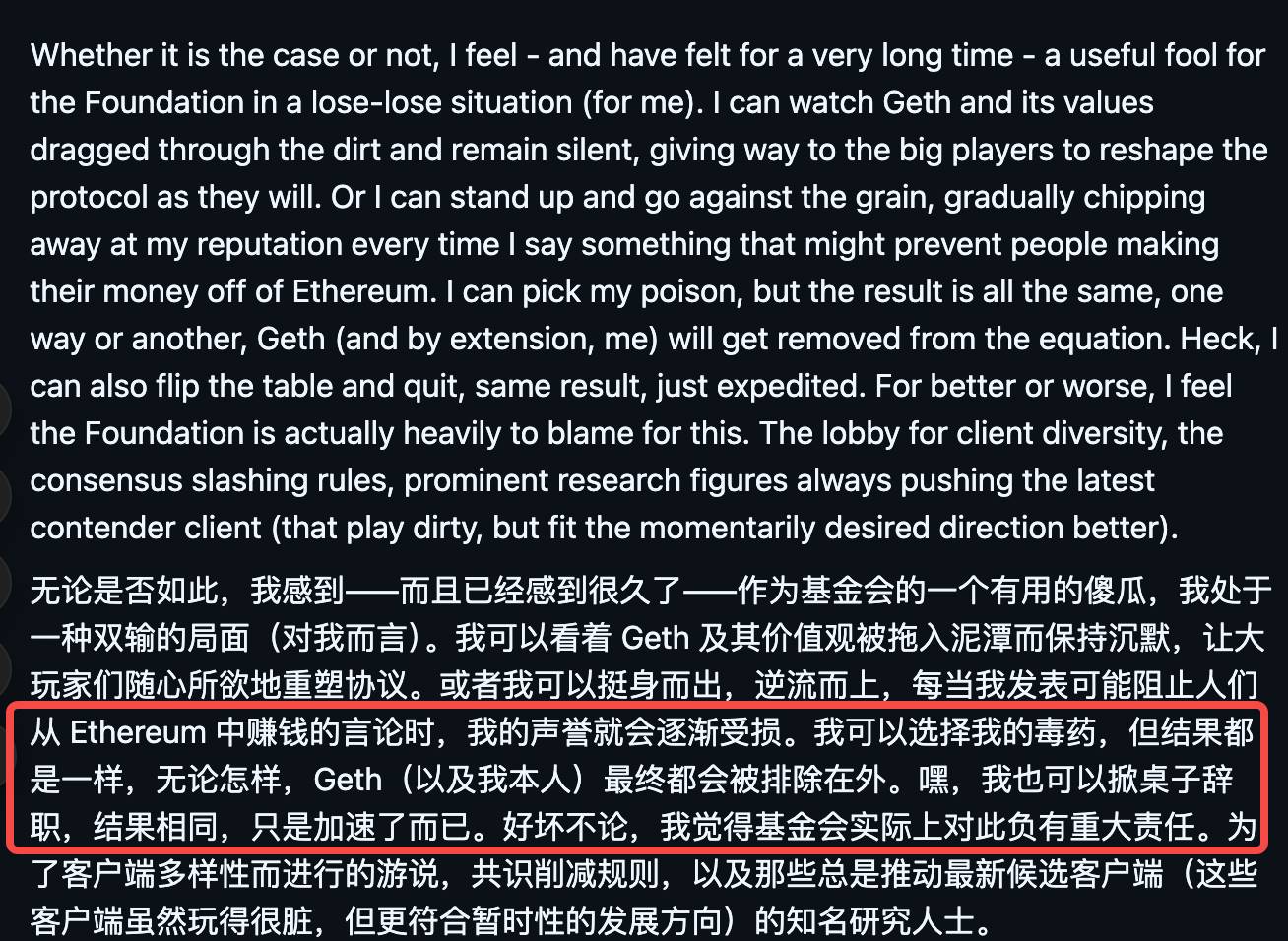
The problem is, every time Peter steps up to challenge those in power or with connections, his credibility suffers. Supporters of those opposing him attack him, accusing him of hindering progress. Over time, he and the Geth team become the problem-makers.
“I can choose to remain silent and watch Ethereum’s values being trampled upon, or I can speak out and gradually destroy my reputation,” he wrote. “Either way, the result is the same—Geth will be marginalized, and I will be excluded.”
Question 2: 6 Annual salary only 60 High cost and low return
During his first six years at Ethereum (2015-2021), Peter earned a total of $625,000. Note that this is the total for all six years, pre-tax, without any equity or incentives. This averages out to about $100,000 per year.
During the same period, the market value of ETH increased from 0 to 450 billion US dollars.
As the person in charge of maintaining the most critical infrastructure of the entire network, Péter's salary may even be lower than that of a newly graduated programmer in Silicon Valley.
He mentioned that other departments of the foundation, such as operations, DevOps, and even some researchers, have lower salaries.
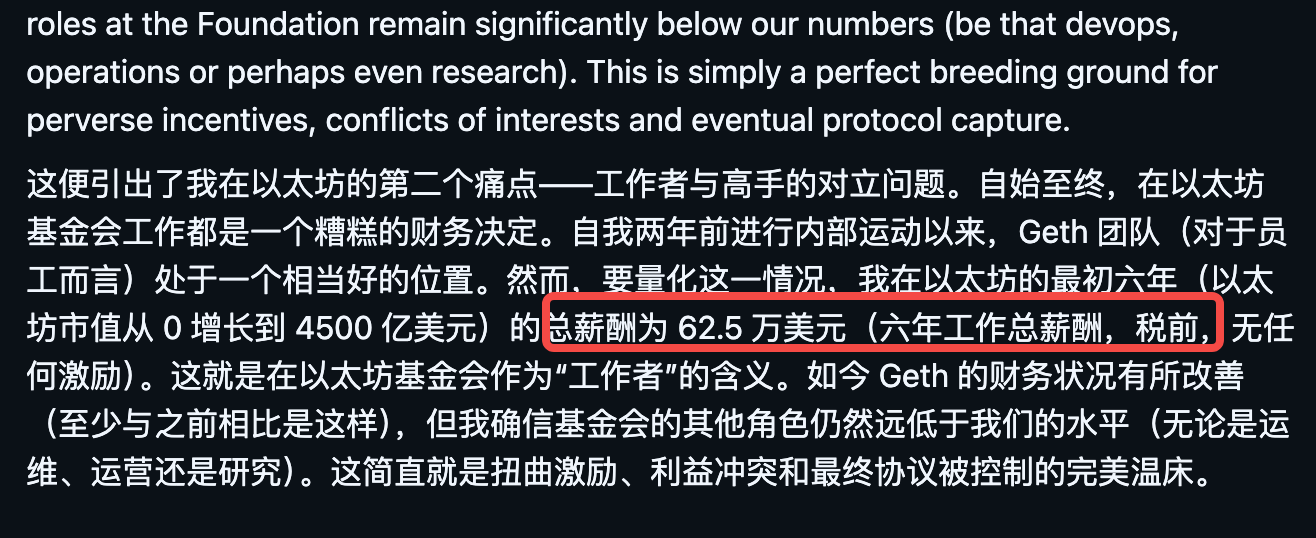
Why is this so? Péter quoted Vitalik: "If someone doesn't complain about being underpaid, then they're paid too much."
Focusing on technology and not caring too much about returns is indeed the ideal image of some technology geeks and cypherpunks. But the problem is that a long-term low-salary culture will have negative consequences.
Those who really care about the development of the protocol are forced to look for compensation outside because they cannot get good salaries within Ethereum.
This led to various conflicts of interest: researchers served as consultants for external projects, and core developers accepted sponsorship privately.
Péter admits bluntly: “Almost all of the foundation’s original employees have already left, because that was the only reasonable way to get compensation commensurate with the value they created.”
Question 3: Vitalik and his circle
The most pointed part of the letter is its analysis of Ethereum’s power structure.
Péter admitted that he had great respect for Vitalik himself, but pointed out a fact:
Whether Vitalik likes it or not, he unilaterally determines the direction of Ethereum. Where Vitalik directs his attention, there he gets the resources.
Whatever project he invests in, it will succeed;
Whatever technical route he approves of will become the mainstream.
Worse still, around Vitalik Formed a "5-10 These people invest in each other, serve as advisors to each other, and control the allocation of resources in the ecosystem.
New projects no longer do public fundraising, but directly look for this 5-10 Individuals. Getting their investment is equivalent to getting a ticket to success.

“If you can get Bankless (a well-known podcaster) to invest, they will praise you on the show. If you can get researchers from foundations to be advisors, it reduces the technical friction.”
This has a flavor of upward management that is familiar to the domestic workplace environment. The key to success is not technology or innovation, but to get the people around Vitalik right.
Question 4: Idealism is the saddest
At the end of the letter, Péter's tone shifted from anger to sadness. He explained that he had turned down numerous high-paying offers over the years because he believed in the ideals of Ethereum.
But now the entire ecosystem is saying "it's just business." He can't accept this mentality, but he also doesn't see a way out.
“I felt like in the grand scheme of things, Geth was seen as a problem, and I was at the center of it.”
The letter was written in May 2024. A year later, in June 2025, Péter left the Ethereum Foundation, reportedly rejecting a $5 million offer from the foundation to spin off Geth as a private company.
He chose to leave completely instead of turning his ideals into a business.
Chain reaction, big boss speaks out
Less than 24 hours after Péter's letter was made public, Polygon founder Sandeep Nailwal couldn't sit still and quoted Péter's post to express his own thoughts.
Polygon is one of Ethereum's largest Layer 2 projects, processing a large number of transactions and hosting numerous applications including the prediction market Polymarket.
It can be said that Polygon has made a huge contribution to the expansion of Ethereum.
But Sandeep says the Ethereum community never really embraced Polygon .
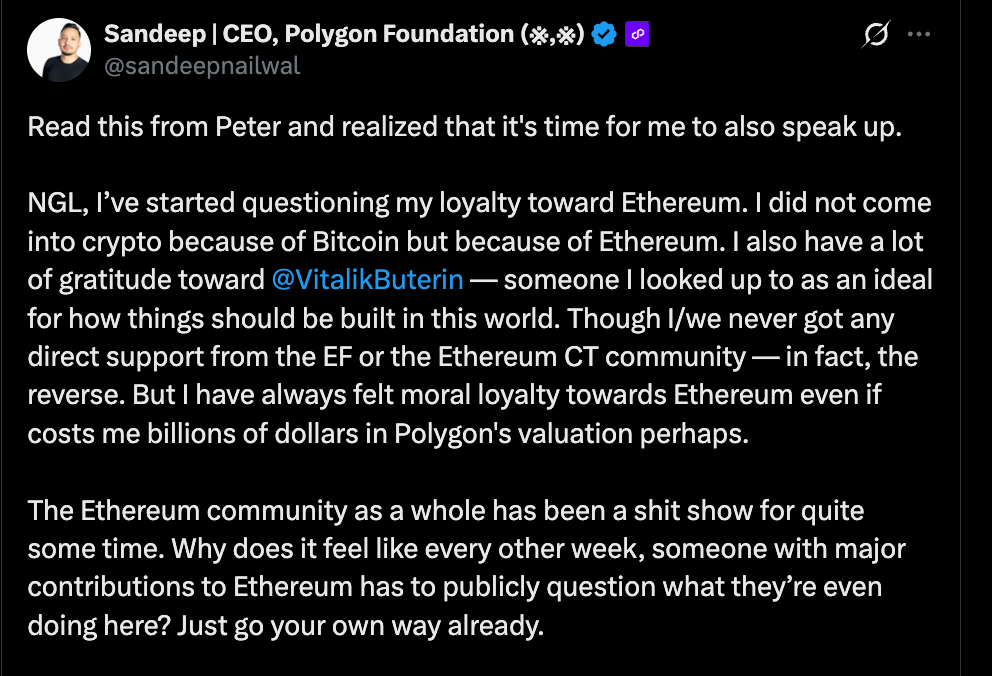
There's a strange double standard in the market, he wrote. "When Polymarket succeeded, the media said it was 'a win for Ethereum.' But Polygon itself? Not Ethereum."
There’s a strange double standard in the market, he wrote. “When Polymarket succeeded, the media said it was ‘a win for Ethereum.’ But Polygon itself? Not Ethereum.”
This is not just a matter of status, but a loss of real money.
Sandeep was even more blunt, pointing out that if Polygon declared itself to be an independent L1 rather than Ethereum's L2, its valuation might immediately increase by 2-5 times.
For example, Hedera Hashgraph, a relatively niche L1 project, has a market capitalization that exceeds the combined market capitalization of the four major L2 projects: Polygon, Arbitrum, Optimism, and Scroll.
As for why he didn’t switch to L1, Sandeep said it was out of moral loyalty to Ethereum, even if this loyalty might cost him billions of dollars in valuation.
But what did this loyalty bring?
Some in the community often claim that Polygon isn't a true L2. GrowthPie, a growth statistics website, refuses to include Polygon's data. Investors don't consider Polygon part of their "Ethereum ecosystem" portfolios.
Sandeep's original post contained a particularly poignant rhetorical question:
“Why are Ethereum contributors questioning themselves every week?”
He mentioned the story of his friend Akshay. Akshay had originally been inclined to support Polygon, but was disgusted by the Ethereum community's crackdown on successful projects and its promotion of "political correctness." Ultimately, he brought his talents to Solana, helping it build its current empire.
Even Polygon's shareholders are questioning his decision, saying that you have a fiduciary responsibility to Polygon, so why sacrifice the company's value for so-called loyalty?
Also speaking out was DeFi legend Andre Cronje.
Andre's post was relatively short but sharp:
“I’m confused. Who is EF paying/supporting? When I was building on ETH, I burned over 700 ETH just to deploy the contracts and infrastructure. I tried to contact EF, but never got a response, no BD contacted me, no funding, zero support, not even a retweet.”
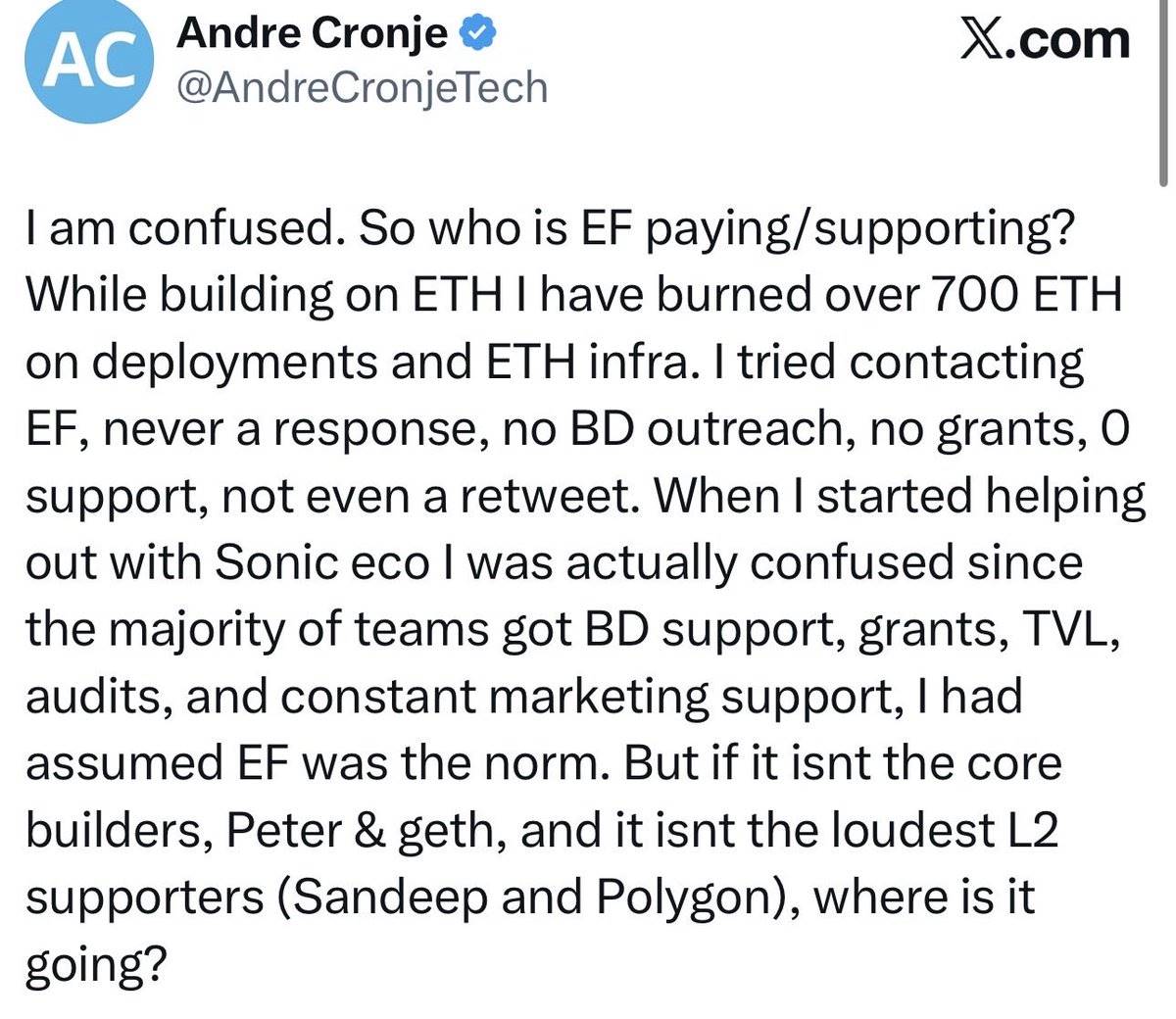
700 ETH is worth about $2.66 million at current prices. All of this was paid out of Andre’s own pocket.
Even more ironic is that when AC started helping the Sonic ecosystem, it was surprised to find that most teams received BD support, funding, liquidity and continued support for audits.
Then, this soul-searching question is even more heartbreaking:
“If the money didn’t go to Peter and Geth, the core builders, and Sandeep and Polygon, the loudest L2 supporters, then where did the money go?”
Vitalik responded by avoiding the real issue
In response to these questions, Vitalik responded to Sandeep's remarks on October 21. His reply was lengthy and included the following:
Detailed list of Polygon's contributions (hosting Polymarket, advancing ZK technology, etc.)
A large article praising Sandeep's charity (donating medical resources to India)
Thanks to Sandeep for returning $190 million in SHIB token gains
It is recommended that Polygon adopt the latest ZK technology upgrade
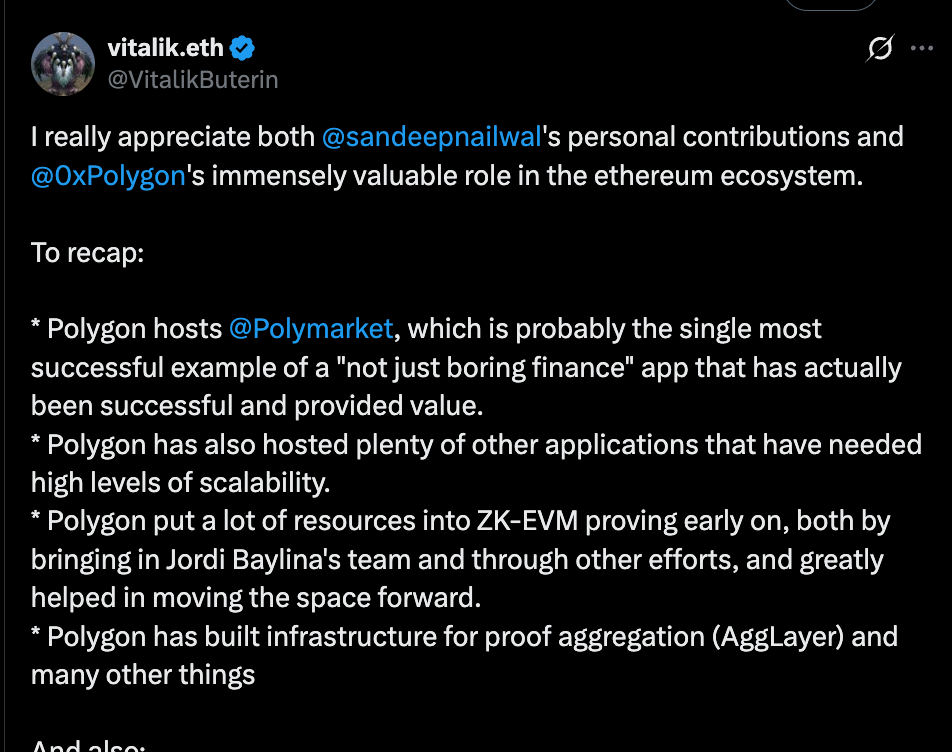
But after reading carefully, you will find that Vitalik did not mention a word about the three core issues: low salaries, lack of transparency in funds, and a small circle of power.
This irrelevant answer may itself be an answer.
Taken together, these responses point to a truth that everyone can see but no one is willing to speak out: there are serious problems with Ethereum's resource allocation.
The most loyal contributors receive no support, while those who are good at "playing the game" receive a lot of resources. The foundation sold more than $200 million in ETH in 2025, but this money obviously did not flow to those who actually built the protocol.
Ethereum’s biggest enemy is the Ethereum Foundation
The uproar sparked by Péter's letter will likely be covered by new hot topics in two weeks, but the issues it reveals will not disappear.
In fact, this kind of collective condemnation of the Ethereum Foundation happens every few months.
For Ethereum today, its biggest enemy is not other chains like Solana, but the Ethereum Foundation.
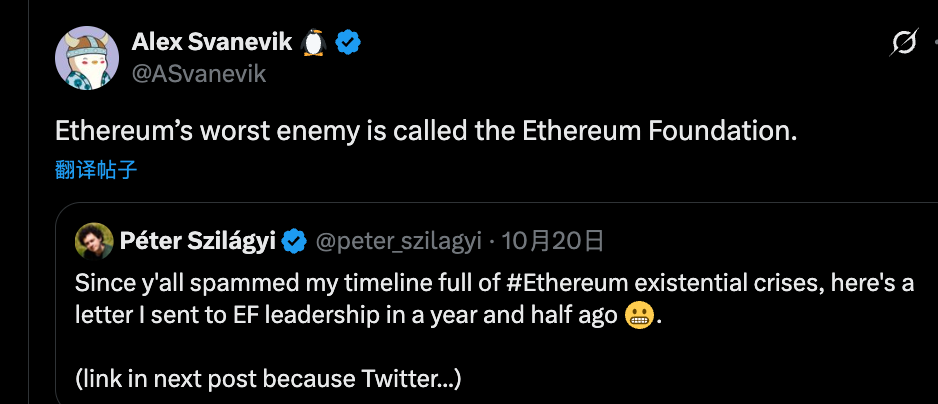
Ethereum has grown from a niche project into a multi-hundred-billion-dollar ecosystem, but its governance structure and culture remain in their early stages.
In Péter's words, the foundation is still using "subtractive thinking" to manage a huge system that requires "additive thinking."
The deeper reason may be that Ethereum has fallen into the typical big company disease.
Ethereum faces all the problems that startups face when they grow larger, such as bureaucracy, factional struggles, and stagnant innovation.
The difference is that traditional companies can respond through equity incentives and management reforms, but Ethereum, as a decentralized project, can neither admit that it is centralized nor truly decentralized.
So the core contradiction we see is: it must maintain the appearance of decentralization, but its actual operation is highly dependent on centralized decision-making.
Vitalik’s existence is a concentrated manifestation of this contradiction.
On the one hand, the community needs his vision and leadership; on the other hand, his very existence negates decentralization.
This creates a peculiar kind of “decentralized theater” where everyone is performing decentralization, but everyone knows where the real power lies.
The cost of such performances is enormous.
As Sandeep pointed out, the Ethereum community is egalitarian on the surface, but in reality it is controlled by a small circle, which is more hypocritical than pure capitalism.
At least on Solana or other centralized chains, the rules of the game are clear.
The ball is now in Vitalik and the Foundation's court. Their choice will impact not only Ethereum but the entire crypto movement. Will they continue to play the decentralization game, or face reality head-on?
Time will tell, but what is certain is that those "useful fools" like Peter will not remain silent forever.
The next outbreak may not be as simple as a letter.




